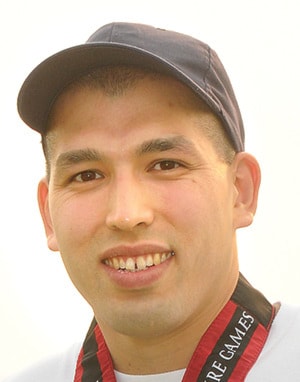Crash simulations, a video, aerial photos and a voice recording figured prominently in Day 4 of the trial of Micah Chan, a Salmon Arm police officer charged with dangerous driving.
Testimony from police and expert witnesses on Thursday, Oct. 23 in Provincial Court in Salmon Arm centred around the speed Chan was driving, the crash of his vehicle and the crash of Courtney Eggen’s.
Eggen, a 21-year-old from Cherryville, was killed when the white 1997 Chevrolet Cavalier she was driving crashed sideways into a dump truck just before midnight on June 20, 2013. The dump truck was parked in the Country Kitchen restaurant parking lot in the 5200 block of Auto Road in the Salmon Arm Industrial Park.
Chan’s police vehicle crashed shortly after, doing a 180-degree turn, sliding backwards down an embankment and coming to rest with its trunk against a building on the opposite side of the road from the dump truck.
According to earlier testimony, Eggen had “blown through” a stop sign at the Five Corners intersection that Chan had been monitoring and he followed her. Chan had reported on the police radio that a vehicle was taking off at speeds of 140 km/hr southbound towards the industrial park.
Defence lawyer Neville McDougall asked that a radio transmission between Const. Kieran Bastians, who was on duty that night, and Chan be played. Bastians testified he had left the detachment when Chan radioed in and his supervisor, Cpl. Luiz Sardinha, told Chan “to shut it down” – meaning turn off the emergency lights and pull over. Sardinha also testified it was not considered a pursuit as Chan had radioed that the vehicle was ‘going away’ from him at 140 km/hr.
Once in his car and heading along 30th Street, Bastians could be heard saying, “Chan, is he taking a left or a right on (Highway) 97?”
Chan had already crashed and his immediate reply sounded tentative.
“We, uh, where am I here?”
The court also saw aerial photos and a video outlining the route.
Previous testimony put Chan’s top speed between 150 and 155 km/hr per hour at some point along the route. Bastians was asked if he knew what speed Chan was travelling when he was asked to shut it down. He said no.
RCMP Sgt. Brian Nightingale, an expert in accident reconstruction, did a speed analysis as well as creating collision simulations of the two crashes.
He testified the Cavalier pushed the dump truck sideways 2.55 metres and was travelling at or near 92 km/hr when it slid sideways into the truck.
The maximum speed at which the vehicle could have safely navigated the curve situated just before the crash site was 106 km/hr, he said. The Cavalier entered the curve at 128 km/hr and exited it at 122. It then travelled 80 to 90 metres before crashing.
Nightingale said he was initially stumped when trying to do a simulation for the police vehicle, a 2009 Crown Victoria, because police cars don’t easily rotate and, in this case, after travelling around a counter-clockwise curve, it should have gone off to the right. He was then instructed to use some assumptions in his report to explain the data collected at the scene.
He went on to explain brake fade, “something I’ve experienced many times in my career.”
When a vehicle is being driven hard or at high speeds, the brakes will heat up, he said.
Nightingale noted GPS data showed Chan’s vehicle went from 155 to 144 km/hr over four seconds. While the deceleration is not overly significant, he said, at that speed the brakes would heat up.
The vehicle entered the curve at 144 km/hr and exited it at 113, with no physical evidence that it was out of control. He noted police are trained to “straighten out the curve.” However, there was a full brake application between 113 and 90 km/hr.
Nightingale said when a hard brake is applied and the front brakes are already experiencing ‘fade,’ the back brakes will do all the work.
“That police car is coming up to the scene, doing a full brake application and the vehicle is experiencing brake fade – and that’s what initiates the rotation.”
He said Chan would have lost control going 87 km/hr, consequently rotating 180 degrees.
When the Crown Victoria went over the embankment backwards, it was going 13 km/hr.
McDougall established that police are not taught about brake fade during their depot training or advanced training.
At the end of Thursday’s testimony, the trial was adjourned until today, Wednesday.
Crown counsel Allan Mandell said he could likely conclude his case today. McDougall said three or four police officers, as well as a civilian witness, may be testifying for the defence.
Judge Anne Wallace said that might not leave time for closing arguments Friday, so it’s not yet known if the trial will conclude this week.
